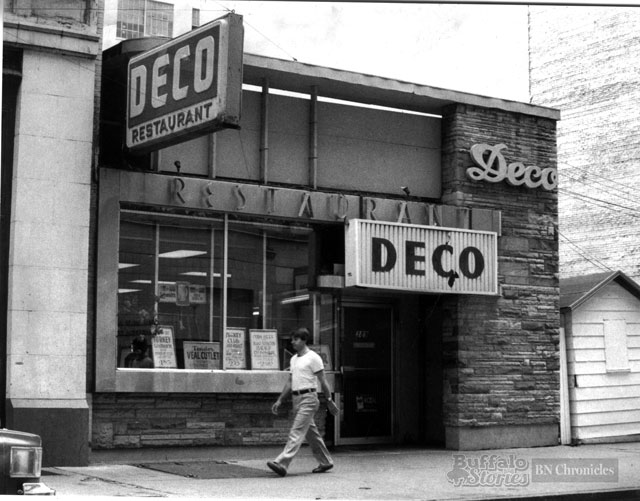 By Steve Cichon
By Steve Cichon
steve@buffalostories.com
@stevebuffalo
Forty-five years ago, Frank Benny’s story was called “the most outstanding comeback in the history of Buffalo broadcasting” by News critic Gary Deeb. Nearly half a century later, that record appears to be intact.

Frank Benny, 1971. (Buffalo News archives)
Benny was a constant on Buffalo radio dials for 25 years. His voice and style were smooth and sonorous. He quickly became Buffalo’s definitive warm, friendly announcer upon coming to WGR Radio in 1965. By 1968, he was a regular on Channel 2 as well, first on the sports desk, and then for nearly a decade as the station’s main weather anchor at 6 and 11.
By 1970, he was one of Buffalo’s most in-demand announcers. He told The News he was generally working on about four hours of sleep. His day started as WGR Radio’s morning man, then he hosted WGR-TV’s Bowling for Dollars and Payday Playhouse 4 o’clock movie, and he did the weather forecasts on Channel 2. He was the NBA Buffalo Braves’ first PA announcer in the 1970-71 season.

1968. (Buffalo Stories archives/Steve Cichon collection)
In five years at WGR, he became one of Buffalo’s most popular media personalities. That was helpful in identifying him the day he robbed a bank on his way home from the radio station in June 1971.
Only minutes after the holdup of the Homestead Savings and Loan at the corner of Main and Chateau Terrace in Snyder netted $503 for a man wearing a stocking over his head and brandishing a (later-found toy) gun, Amherst Police were arresting Benny at gunpoint in the driveway of his Williamsville home.
The case was a local sensation. Management at WGR and at least three other stations ordered that the on-air staff not make any snide remarks or jokes at Benny’s expense. One notable exception was Channel 7, where the 6 p.m. “Eyewitness News Reel” featured the title card “Forecast: Cloudy” for the otherwise-straight Benny story. At 11, the title was changed to “Under the Weather.”
The disc jockey, TV weather man and father of two was charged with third-degree robbery and was tried in a non-jury trial. The prosecution rested when Benny’s attorney agreed to the facts of the case — that the announcer had indeed stuck up the bank — but that the he was innocent of the charges in the “poorly planned, ludicrous robbery” because he was temporarily insane.
Four psychiatrists testified that Benny was “not in sufficient possession of his faculties at the time of the holdup.” A Buffalo General psychiatrist who had examined Benny said that the temporary mental illness was caused by extreme and prolonged stress.
First, Benny was a central figure in a protracted labor strike at WGR AM-FM-TV. Eighty members of NABET, the union representing nearly all the operations personnel and announcers at WGR, spent nine months on strike. About 10 — including Benny — crossed picket lines to continue to work. Station management provided Benny an armed guard after rocks were thrown through the windows of his home and his family was threatened.
Benny’s family was also threatened the very morning of the robbery. He’d racked up thousands of dollars of gambling debts, and the bookmakers were calling in their markers — or else.
In October 1971, the judge found Benny not guilty by reason of mental disease, and he was ordered to spend two weeks at Buffalo State Hospital.
Then, in December, within six months of the robbery, Benny was back on WGR Radio and TV. Having been found not guilty, and “on a wave of public sympathy,” management thought it was the right thing to do.
“A lot of people have told me that it takes guts to do this, to go back on the air,” Benny told The News during his first week back at WGR. “But to me, it’s not a courageous thing. It’s a simple case of going back to what I know.”
That’s not to say that Benny wasn’t thankful.
“It’s hard to fathom that people can be that nice,” Benny told News critic Deeb. “It’s nice to know people can be forgiven.”
All told, Benny spent 19 years at WGR, walking away from the station in 1985. For a year and a half, he was the morning man at WYRK Radio, before finishing out the ’80s as a weekend staffer at WBEN.

Frank Benny at WGR in 1983 (Buffalo News archives)
No matter what his personal life sounded like, he always sounded like Frank Benny on the radio. After leaving WBEN Radio in 1989, Benny left for Florida, where he was on the radio for 16 years — until he died in 2005 at age 67.
 By Steve Cichon
By Steve Cichon







 1959 (Buffalo Stories archives/Steve Cichon collection)
1959 (Buffalo Stories archives/Steve Cichon collection)













